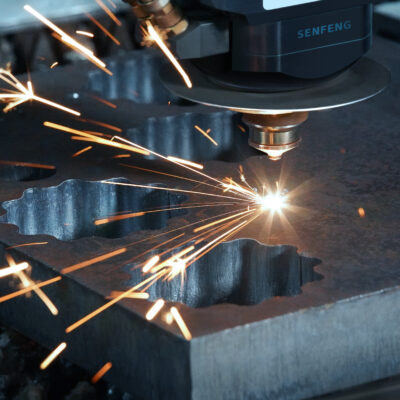Brass, a versatile metal primarily made of copper and zinc, is widely used across various industries in the U.S.—from architectural applications, decorative components to electrical, mechanical parts. Cutting brass at high precision and fast speed is critical in today’s fast-paced manufacturing context, which is why fiber laser cutters have emerged as a favored solution.
I. Why Use Fiber Laser Cutters for Brass?
1. Superior Laser Beam
Fiber lasers produce highly focused and stable beams ideal for cutting reflective metals like brass and stainless steel. The shorter wavelength (around 1.06 μm) allows for the better absorption by non-ferrous metals, which boosts cutting efficiency and reduces the risk of beam reflection that may damage the machine.
2. Non-Contact Precision
Since fiber laser cutting is non-contact, it exerts no mechanical stress on brass sheet. This is crucial for maintaining the integrity of thinner brass or complex geometries.
3. Cut at Fast Speed
Compared with traditional CO₂ lasers or mechanical cutting, fiber lasers offer faster cutting speed, especially when dealing with thin to medium-thickness brass (under 0.24 inch). This changes into the higher throughput and lower labor costs—a major advantage for U.S. manufacturers under pressure to deliver products quickly.
II. Advantages of Fiber Laser Cutting for Brass
1. Smooth Cutting Edges
Fiber lasers produce clean, burr-free edges that often need no postprocessing, which is critical for industries like interior design and signage where aesthetics matter.
2. Less Operating Costs
Fiber lasers need lower power consumption than CO₂ lasers and require minimal maintenance. Their longer lifespan and fewer consumables make them cost-effective over time, especially for U.S. job shops and metal manufacturers.
3. Automation Options
Many American manufacturers are moving towards Industry 4.0 automation. For this reason, modern fiber laser machines are often equipped with:
Fully/semi-automatic loading & unloading systems
Real-time monitoring devices
CNC and CAD/CAM software integration
This raises overall productivity and reduces heavy reliance on skilled labors, which is in shortage in many parts of the U.S.
III. Major Challenges of Cutting Brass with Fiber Lasers
1. High Reflectivity
Brass is a highly reflective metal, particularly in its raw form. Without proper settings or protective technologies, it can reflect laser beams back into laser source, potentially injuring its laser optics or laser generator. That’s why most modern fiber lasers designed for brass are outfitted with anti-reflection features and protective isolators.
2. Oxidation and Surface Discoloration
Brass is likely to be oxidized when being exposed to oxygen during cutting. To minimize this, many U.S. users opt for nitrogen as assist gas, which can prevent oxidation and preserve the clean, golden surface finish desired in decorative applications.
IV. Best Practices for Cutting Brass with Fiber Lasers
1. Use Protective Measures for Reflection
Invest in a machine with built-in reflected beam protection and auto-shutoff features. These are standard on high-quality fiber lasers made for the North American markets.
2. Employ Assist Gas
Nitrogen is commonly used to avoid oxidation and preserve edge color.
Air can be used for lower-cost operations but may result in discoloration.
Oxygen is generally avoided due to higher risk of oxidation and reduced cut quality.
3. Keep Surface Clean Before Cutting
Any oil, oxide, or dirt on the brass may affect cutting performance. Use pre-cleaning methods like alcohol wipes or ultrasonic cleaners for consistent results.
4. Control Heat Input
Excessive heat can lead to warping or edge burring. Choose machines that allow fine-tuning of laser power, frequency, and speed for brasses of different thicknesses.
V. What to Look for When Buying Brass-Cutting Fiber Laser Cutter
1. Laser Power Output
For brass up to 0.24 inch, a 1.5kW to 4kW fiber laser is typically enough. Other thicker sheets may require higher power, but be aware of greater reflectivity risks.
2. Size of Cutting Table
Consider your typical sheet size. U.S. standard sizes like 4’x8’ (48*96 inches) are commonly supported. A larger table provides flexibility for mass production.
3. Compatibility with Reflective Materials
Look for manufacturers that explicitly mention compatibility with highly-reflective metals like brass, copper and aluminum. This is secured by optics and laser source designed to handle such special metals.
4. Technical Support and Warranty Period
U.S. buyers should prioritize suppliers that offer:
Local service centers and spare parts inventory
U.S.-based (or online) training and after-sales supports
Extended warranty period (at least 2 years for laser source)
5. Software Integration
Check for compatibility with AutoCAD, SolidWorks, or nesting software commonly used in American design and manufacturing workflows.
VI. Costs of a Fiber Laser Cutter for Brass in the U.S.
Selling price depends on laser power, level of automation, machine tool bed and other specifications, but general ranges include:
Entry-level 1.5–3kW machines: $40,000–$90,000
Mid-range 4–8kW with automation: $90,000–$150,000
Hi-end industrial 8kW+ systems: $150,000–$300,000+
U.S. buyers may also benefit from Section 179 tax deductions, which allow you to deduct the full price of qualifying machines.
VII. Typical Industries in the U.S. Using Fiber Laser to Cut Brass
Architecture and Interior Design–for cutting intricate brass panels, screens, signage, and trims.
Electronics–where brass is often used for connectors, terminals, and casings due to its conductivity.
Jewelry and Decorative Arts–precision cutting of custom-made shapes in brass for affordable and elegant designs.
HVAC and Plumbing–manufacturing components like flanges, plates, and brackets.
Automotive and Aerospace–for small components requiring tight tolerances.
VIII. Final Conclusion
Brass is a rewarding but challenging metal to cut, and fiber laser cutters are rising to those challenges. With their high precision, efficiency, and adaptability, they provide American manufacturers with a competitive edge, especially when equipped with features tailored to highly-reflective metals.
Whether you’re a small job shop in Ohio or a large metalworks facility in Texas, investing in a fiber laser cutter for brass will unlock opportunities for new business in architectural, electrical or high-precision industries.
Be sure to choose a machine that balances laser power, operating safety, software compatibility and after-sales support to match your specific production needs.
